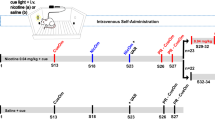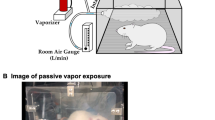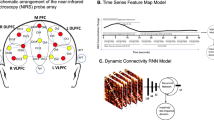Abstract
Although it is more common for drug abuse to progress from tobacco to cannabis, in many cases cannabis use develops before tobacco use. Epidemiological evidence indicates that prior cannabis use increases the likelihood of becoming dependent on tobacco. To determine whether this effect might be due to cannabis exposure per se, in addition to any genetic, social, or environmental factors that might contribute, we extended our series of studies on ‘gateway drug’ effects in animal models of drug abuse. Rats were exposed to THC, the main psychoactive constituent of cannabis, for 3 days (two intraperitoneal injections/day). Then, starting 1 week later, they were allowed to self-administer nicotine intravenously. THC exposure increased the likelihood of acquiring the nicotine self-administration response from 65% in vehicle-exposed rats to 94% in THC-exposed rats. When the price of nicotine was manipulated by increasing the response requirement, THC-exposed rats maintained higher levels of intake than vehicle-exposed rats, indicating that THC exposure increased the value of nicotine reward. These results contrast sharply with our earlier findings that prior THC exposure did not increase the likelihood of rats acquiring either heroin or cocaine self-administration, nor did it increase the reward value of these drugs. The findings obtained here suggest that a history of cannabis exposure might have lasting effects that increase the risk of becoming addicted to nicotine.
Similar content being viewed by others
Log in or create a free account to read this content
Gain free access to this article, as well as selected content from this journal and more on nature.com
or
References
Adriani W, Deroche-Gamonet V, Le Moal M, Laviola G, Piazza PV (2006). Preexposure during or following adolescence differently affects nicotine-rewarding properties in adult rats. Psychopharmacology (Berl) 184: 382–390.
Agrawal A, Budney AJ, Lynskey MT (2012). The co-occurring use and misuse of cannabis and tobacco: a review. Addiction 107: 1221–1233.
Agrawal A, Madden PA, Bucholz KK, Heath AC, Lynskey MT (2008). Transitions to regular smoking and to nicotine dependence in women using cannabis. Drug Alcohol Depend 95: 107–114.
Agrawal A, Scherrer JF, Lynskey MT, Sartor CE, Grant JD, Haber JR et al (2011). Patterns of use, sequence of onsets and correlates of tobacco and cannabis. Addict Behav 36: 1141–1147.
Amos A, Wiltshire S, Bostock Y, Haw S, McNeill A (2004). ‘You can’t go without a fag. you need it for your hash’—a qualitative exploration of smoking, cannabis and young people. Addiction 99: 77–81.
Anthony JC, Warner LA, Kessler RC (1994). Comparative epidemiology of dependence on tobacco, alcohol, controlled substances, and inhalants: basic findings from the national comorbidity survey. Exp Clin Psychopharmacol 2: 244–268.
Berrendero F, Robledo P, Trigo JM, Martín-García E, Maldonado R (2010). Neurobiological mechanisms involved in nicotine dependence and reward: participation of the endogenous opioid system. Neurosci Biobehav Rev 35: 220–231.
Bruijnzeel AW, Markou A (2003). Characterization of the effects of bupropion on the reinforcing properties of nicotine and food in rats. Synapse 50: 20–28.
Cadoni C, Pisanu A, Solinas M, Acquas E, Di Chiara G (2001). Behavioural sensitization after repeated exposure to Delta 9-tetrahydrocannabinol and cross-sensitization with morphine. Psychopharmacology (Berl) 158: 259–266.
Cahill K, Ussher M (2007). Cannabinoid type 1 receptor antagonists (rimonabant) for smoking cessation. Cochrane Database Syst Rev 2007: CD005353.
Castañé A, Berrendero F, Maldonado R (2005). The role of the cannabinoid system in nicotine addiction. Pharmacol Biochem Behav 81: 381–386.
Chaudhri N, Caggiula AR, Donny EC, Booth S, Gharib M, Craven L et al (2007). Self-administered and noncontingent nicotine enhance reinforced operant responding in rats: impact of nicotine dose and reinforcement schedule. Psychopharmacology (Berl) 190: 353–362.
CIRRUS Study Group. Rigotti NA, Gonzales D, Dale LC, Lawrence D, Chang Y (2009). A randomized controlled trial of adding the nicotine patch to rimonabant for smoking cessation: efficacy, safety and weight gain. Addiction 104: 266–276.
Coen KM, Adamson KL, Corrigall WA (2009). Medication-related pharmacological manipulations of nicotine self-administration in the rat maintained on fixed- and progressive-ratio schedules of reinforcement. Psychopharmacology (Berl) 201: 557–568.
Cohen C, Perrault G, Voltz C, Steinberg R, Soubrie P (2002). SR141716, a central cannabinoid (CB(1)) receptor antagonist, blocks the motivational and dopamine-releasing effects of nicotine in rats. Behav Pharmacol 13: 451–463.
Corrigall WA (1991). A rodent model for nicotine self-administration. In: Boulton A,, Baker GB, Wu PH, (eds). Animal Models of Drug Addiction. Neuromethods Vol 21. Humana: Clifton, NJ). pp 315–344.
Corrigall WA, Coen KM, Zhang J, Adamson KL (2001). GABA mechanisms in the pedunculopontine tegmental nucleus influence particular aspects of nicotine self-administration selectively in the rat. Psychopharmacology (Berl) 158: 190–197.
Corrigall WA, Franklin KB, Coen KM, Clarke PB (1992). The mesolimbic dopaminergic system is implicated in the reinforcing effects of nicotine. Psychopharmacology (Berl) 107: 285–289.
Degenhardt L, Chiu WT, Conway K, Dierker L, Glantz M, Kalaydjian A et al (2009). Does the 'gateway' matter? Associations between the order of drug use initiation and the development of drug dependence in the National Comorbidity Study Replication. Psychol Med 39: 157–167.
Donny EC, Caggiula AR, Mielke MM, Jacobs KS, Rose C, Sved AF (1998). Acquisition of nicotine self-administration in rats: the effects of dose, feeding schedule, and drug contingency. Psychopharmacology (Berl) 136: 83–90.
Ellgren M, Artmann A, Tkalych O, Gupta A, Hansen HS, Hansen SH et al (2008). Dynamic changes of the endogenous cannabinoid and opioid mesocorticolimbic systems during adolescence: THC effects. Eur Neuropsychopharmacol 18: 826–834.
Ellgren M, Spano SM, Hurd YL (2007). Adolescent cannabis exposure alters opiate intake and opioid limbic neuronal populations in adult rats. Neuropsychopharmacology 32: 607–615.
Fergusson DM, Boden JM, Horwood LJ (2006). Cannabis use and other illicit drug use: testing the cannabis gateway hypothesis. Addiction 101: 556–569.
Forget B, Hamon M, Thiebot MH (2005). Cannabinoid CB1 receptors are involved in motivational effects of nicotine in rats. Psychopharmacology (Berl) 181: 722–734.
Freeman KB, Woolverton WL (2009). Self-administration of cocaine and nicotine mixtures by rhesus monkeys. Psychopharmacology (Berl) 207: 99–106.
Gamaleddin I, Wertheim C, Zhu AZ, Coen KM, Vemuri K, Makryannis A et al (2012). Cannabinoid receptor stimulation increases motivation for nicotine and nicotine seeking. Addict Biol 17: 47–61.
Gerber GJ, Wise RA (1989). Pharmacological regulation of intravenous cocaine and heroin self-administration in rats: a variable dose paradigm. Pharmacol Biochem Behav 32: 527–531.
Gould RW, Czoty PW, Nader SH, Nader MA (2011). Effects of varenicline on the reinforcing and discriminative stimulus effects of cocaine in rhesus monkeys. J Pharmacol Exp Ther 339: 678–686.
Hadjiconstantinou M, Neff NH (2011). Nicotine and endogenous opioids: neurochemical and pharmacological evidence. Neuropharmacology 60: 1209–1220.
Hall WD, Lynskey M (2005). Is cannabis a gateway drug? Testing hypotheses about the relationship between cannabis use and the use of other illicit drugs. Drug Alcohol Rev 24: 39–48.
Harvey DM, Yasar S, Heishman SJ, Panlilio LV, Henningfield JE, Goldberg SR (2004). Nicotine serves as an effective reinforcer of intravenous drug-taking behavior in human cigarette smokers. Psychopharmacology (Berl) 175: 134–142.
Hursh SR, Silberberg A (2008). Economic demand and essential value. Psychol Rev 115: 186–198.
Kandel DB (1975). Stages in adolescent involvement in drug use. Science 190: 912–914.
Kandel DB, Yamaguchi K, Chen K (1992). Stages of progression in drug involvement from adolescence to adulthood: further evidence for the gateway theory. J Stud Alcohol 53: 447–457.
Kandel DB, Yamaguchi K, Klein LC (2006). Testing the gateway hypothesis. Addiction 101: 470–472.
Le Foll B, Forget B, Aubin HJ, Goldberg SR (2008). Blocking cannabinoid CB1 receptors for the treatment of nicotine dependence: insights from pre-clinical and clinical studies. Addict Biol 13: 239–252.
Le Foll B, Goldberg SR (2004). Rimonabant, a CB1 antagonist, blocks nicotine-conditioned place preferences. Neuroreport 15: 2139–2143.
Le Foll B, Goldberg SR (2009). Effects of nicotine in experimental animals and humans: an update on addictive properties. Handb Exp Pharmacol 192: 335–367.
Lee JP, Battle RS, Lipton R, Soller B (2010). ‘Smoking’: use of cigarettes, cigars and blunts among Southeast Asian American youth and young adults. Health Educ Res 25: 83–96.
MacCoun R (1998). In what sense (if any) is marijuana a gateway drug? Drug Policy Anal Bull 4: 5–8.
MacCoun RJ (2006). Competing accounts of the gateway effect: the field thins, but still no clear winner. Addiction 101: 473–474.
Mackay J, Eriksen M (2002) The Tobacco Atlas. World Health Organization: Geneva.
Maldonado R (2002). Study of cannabinoid dependence in animals. Pharmacol Ther 95: 153–164.
Martín-Santos R, Fagundo AB, Crippa JA, Atakan Z, Bhattacharyya S, Allen P et al (2010). Neuroimaging in cannabis use: a systematic review of the literature. Psychol Med 40: 383–398.
Mascia P, Pistis M, Justinova Z, Panlilio LV, Luchicchi A, Lecca S et al (2011). Blockade of nicotine reward and reinstatement by activation of alpha-type peroxisome proliferator-activated receptors. Biol Psychiatry 69: 633–641.
Maskos U, Molles BE, Pons S, Besson M, Guiard BP, Guilloux JP et al (2005). Nicotine reinforcement and cognition restored by targeted expression of nicotinic receptors. Nature 436: 103–107.
Mello NK, Newman JL (2011). Discriminative and reinforcing stimulus effects of nicotine, cocaine, and cocaine+nicotine combinations in Rhesus Monkeys. Exp Clin Psychopharmacol 19: 203–214.
Morral AR, McCaffrey DF, Paddock SM (2002). Reassessing the marijuana gateway effect. Addiction 97: 1493–1504.
Palmatier MI, Liu X, Caggiula AR, Donny EC, Sved AF (2007). The role of nicotinic acetylcholine receptors in the primary reinforcing and reinforcement-enhancing effects of nicotine. Neuropsychopharmacology 32: 1098–1108.
Panlilio LV, Justinova Z, Mascia P, Pistis M, Luchicchi A, Lecca S et al (2012). Novel use of a lipid-lowering fibrate medication to prevent nicotine reward and relapse: preclinical findings. Neuropsychopharmacology 37: 1838–1847.
Panlilio LV, Schindler CW (2000). Self-administration of remifentanil, an ultra-short acting opioid, under continuous and progressive-ratio schedules of reinforcement in rats. Psychopharmacology (Berl) 150: 61–66.
Panlilio LV, Solinas M, Matthews SA, Goldberg SR (2007). Previous exposure to THC alters the reinforcing efficacy and anxiety-related effects of cocaine in rats. Neuropsychopharmacology 32: 646–657.
Panlilio LV, Thorndike EB, Schindler CW (2008). A stimulus-control account of regulated drug intake in rats. Psychopharmacology (Berl) 196: 441–450.
Patton GC, Coffey C, Carlin JB, Sawyer SM, Lynskey M (2005). Reverse gateways? Frequent cannabis use as a predictor of tobacco initiation and nicotine dependence. Addiction 100: 1518–1525.
Peartree NA, Sanabria F, Thiel KJ, Weber SM, Cheung TH, Neisewander JL (2012). A new criterion for acquisition of nicotine self-administration in rats. Drug Alcohol Depend 124: 63–69.
Prescot AP, Locatelli AE, Renshaw PF, Yurgelun-Todd DA (2011). Neurochemical alterations in adolescent chronic marijuana smokers: a proton MRS study. Neuroimage 57: 69–75.
Risner ME, Goldberg SR (1983). A comparison of nicotine and cocaine self-administration in the dog: fixed-ratio and progressive-ratio schedules of intravenous drug infusion. J Pharmacol Exp Ther 224: 319–326.
Ross JT, Corrigall WA, Heidbreder CA, LeSage MG (2007). Effects of the selective dopamine D3 receptor antagonist SB-277011A on the reinforcing effects of nicotine as measured by a progressive-ratio schedule in rats. Eur J Pharmacol 559: 173–179.
Rubino T, Forlani G, Viganò D, Zippel R, Parolaro D (2004). Modulation of extracellular signal-regulated kinases cascade by chronic delta 9-tetrahydrocannabinol treatment. Mol Cell Neurosci 25: 355–362.
Rubino T, Viganò D, Massi P, Parolaro D (2003). Cellular mechanisms of Delta 9-tetrahydrocannabinol behavioural sensitization. Eur J Neurosci 17: 325–330.
Scherma M, Panlilio LV, Fadda P, Fattore L, Gamaleddin I, Le Foll B et al (2008). Inhibition of anandamide hydrolysis by cyclohexyl carbamic acid 3'-carbamoyl-3-yl ester (URB597) reverses abuse-related behavioral and neurochemical effects of nicotine in rats. J Pharmacol Exp Ther 327: 482–490.
Schweinsburg AD, Brown SA, Tapert SF (2008). The influence of marijuana use on neurocognitive functioning in adolescents. Curr Drug Abuse Rev 1: 99–111.
Shoaib M (2008). The cannabinoid antagonist AM251 attenuates nicotine self-administration and nicotine-seeking behaviour in rats. Neuropharmacology 52: 438–444.
Shoaib M, Schindler CW, Goldberg SR (1997). Nicotine self-administration in rats: strain and nicotine pre-exposure effects on acquisition. Psychopharmacology (Berl) 129: 35–43.
Shoaib M, Swanner LS, Yasar S, Goldberg SR (1999). Chronic caffeine exposure potentiates nicotine self-administration in rats. Psychopharmacology (Berl) 142: 327–333.
Siqueira LM, Brook JS (2003). Tobacco use as a predictor of illicit drug use and drug-related problems in Colombian youth. J Adolesc Health 32: 50–57.
Solinas M, Goldberg SR, Piomelli D (2008). The endocannabinoid system in brain reward processes. Br J Pharmacol 154: 369–383.
Solinas M, Panlilio LV, Goldberg SR (2004). Exposure to delta-9-tetrahydrocannabinol (THC) increases subsequent heroin taking but not heroin's reinforcing efficacy: a self-administration study in rats. Neuropsychopharmacology 29: 1301–1311.
Stapleton J (1998). Cigarette smoking prevalence, cessation and relapse. Stat Methods Med Res 7: 187–203.
Tarter RE, Vanyukov M, Kirisci L, Reynolds M, Clark DB (2006). Predictors of marijuana use in adolescents before and after licit drug use: examination of the gateway hypothesis. Am J Psychiatry 163: 2134–2140.
Timberlake DS, Haberstick BC, Hopfer CJ, Bricker J, Sakai JT, Lessem JM et al (2007). Progression from marijuana use to daily smoking and nicotine dependence in a national sample of U.S. adolescents. Drug Alcohol Depend 88: 272–281.
Tullis LM, Dupont R, Frost-Pineda K, Gold MS (2003). Marijuana and tobacco: a major connection? J Addict Dis 22: 51–62.
Valjent E, Mitchell JM, Besson MJ, Caboche J, Maldonado R (2002). Behavioural and biochemical evidence for interactions between Delta 9-tetrahydrocannabinol and nicotine. Br J Pharmacol 135: 564–578.
Vanyukov MM, Tarter RE, Kirillova GP, Kirisci L, Reynolds MD, Kreek MJ et al (2012). Common liability to addiction and ‘gateway hypothesis’: theoretical, empirical and evolutionary perspective. Drug Alcohol Depend 123: S3–S17.
Vaughn M, Wallace J, Perron B, Copeland V, Howard M (2008). Does marijuana use serve as a gateway to cigarette use for high-risk African-American youth? Am J Drug Alcohol Abuse 34: 782–791.
Viganò D, Rubino T, Vaccani A, Bianchessi S, Marmorato P, Castiglioni C et al (2005). Molecular mechanisms involved in the asymmetric interaction between cannabinoid and opioid systems. Psychopharmacology (Berl) 182: 527–536.
Viveros MP, Marco EM, File SE (2006). Nicotine and cannabinoids: parallels, contrasts and interactions. Neurosci Biobehav Rev 30: 1161–1181.
Wagner FA, Anthony JC (2002). Into the world of illegal drug use: exposure opportunity and other mechanisms linking the use of alcohol, tobacco, marijuana, and cocaine. Am J Epidemiol 155: 918–925.
Wells JE, McGee MA (2008). Violations of the usual sequence of drug initiation: prevalence and associations with the development of dependence in the New Zealand Mental Health Survey. J Stud Alcohol Drugs 69: 789–795.
Werling LL, Reed SC, Wade D, Izenwasser S (2009). Chronic nicotine alters cannabinoid-mediated locomotor activity and receptor density in periadolescent but not adult male rats. Int J Dev Neurosci 27: 263–269.
Acknowledgements
This research was supported by the Intramural Research Program of the NIH, National Institute on Drug Abuse. Thanks to Syrena Bracey for assistance in conducting the experiments.
Author information
Authors and Affiliations
Corresponding author
Ethics declarations
Competing interests
The authors declare no conflict of interest.
Rights and permissions
About this article
Cite this article
Panlilio, L., Zanettini, C., Barnes, C. et al. Prior Exposure to THC Increases the Addictive Effects of Nicotine in Rats. Neuropsychopharmacol 38, 1198–1208 (2013). https://doi.org/10.1038/npp.2013.16
Received:
Revised:
Accepted:
Published:
Issue date:
DOI: https://doi.org/10.1038/npp.2013.16
Keywords
This article is cited by
-
Increased elasticity of sucrose demand during hyperdopaminergic states in rats
Psychopharmacology (2022)
-
Chronic ∆-9-tetrahydrocannabinol administration delays acquisition of schedule-induced drinking in rats and retains long-lasting effects
Psychopharmacology (2022)
-
HCV cure: an appropriate moment to reduce cannabis use in people living with HIV? (ANRS CO13 HEPAVIH data)
AIDS Research and Therapy (2022)
-
Pharmacokinetic, behavioral, and brain activity effects of Δ9-tetrahydrocannabinol in adolescent male and female rats
Neuropsychopharmacology (2021)
-
Marijuana Use and Sexual Risk Behavior Among Young Black Men Who Have Sex with Men in California
Journal of Racial and Ethnic Health Disparities (2021)



